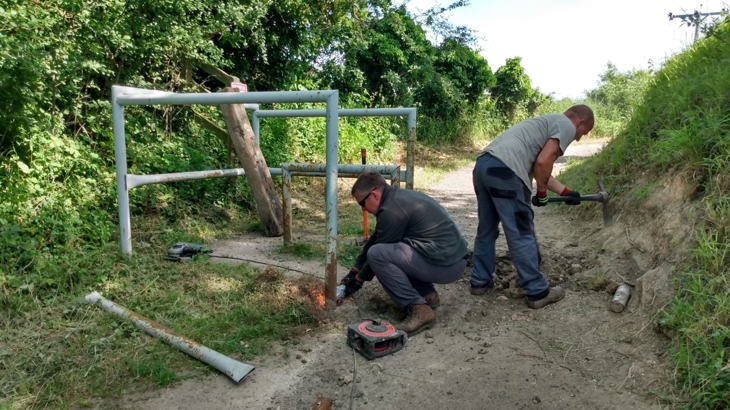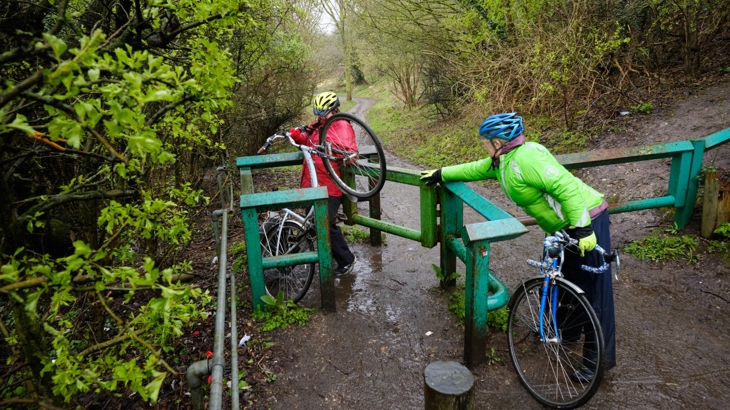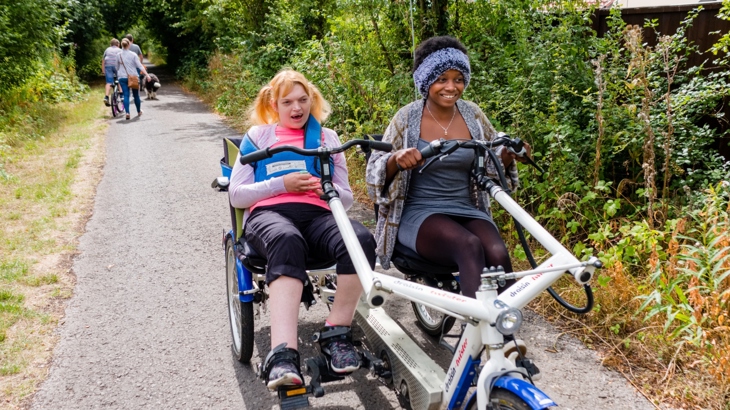As custodians of the National Cycle Network, we’re committed to making it safe and accessible for everyone. Martyn Brunt, our Land Manager for the Midlands and East, discusses the work it takes to remove barriers which prevent people from using paths.

Martyn Brunt's team in the Midlands removing a barrier on National Route 41 around Draycote Water.
"Why can’t you just go out one night and chop them off with an angle grinder?"
These are the words I often hear when I tell people that part of my job is removing barriers from the National Cycle Network.
It’s an opinion I have some sympathy with – not least because there’s something appealing about the image people have of me moving through the dark like a saboteur behind enemy lines, armed with a portable buzz saw.
But it’s mostly because it really should be that easy. However, real life is never that simple.
A work in progress
So far across the Midlands, my maintenance team and I have removed nearly 30 chicanes, A frames, gates and other barriers from the Network.
Teams across all other regions are also proving that this work really can be done.
The barriers we've removed in the Midlands were located from Staffordshire to Lincolnshire.
The majority of these obstacles were on paths that Sustrans owns.
Contrary to popular belief, we don’t own all 12,763 miles of the Network, but just 271, or 2%.
The barriers we tackle are ones that prevent members of the public from easily accessing paths.
This includes people with trikes, trailers, cargo bikes, prams, wheelchairs, mobility scooters and, in some cases, standard bicycles.
In the best cases, barriers force people to get off their cycles to get through.
And in the worst, they stop people from getting onto a route altogether.

Gates and barriers like these can be difficult for bicycle users, but they can also completely prevent disabled people from accessing a path.
Checking planning permission
So how are barriers removed?
You’d think it would be easy on our own land, but even this has hidden pitfalls.
Before I can fire up the cutter, I have to check what the barrier is doing there in the first place.
In some cases, barriers were installed when the routes were built 20 years ago as a condition of the planning permission – no barrier, no route.
I therefore have to try and find out if chopping one out breaches planning consent.
This isn’t easy when you’re trying to go back two decades to find out who agreed to what.
Working with other landowners
We encounter similar difficulties when tackling barriers on other landowners’ properties.
Trying to find out whose barrier it is in the first place is often a challenge, and working out why it was put there is even harder.
But these are still things I have to find out, or I’m no more than a vandal committing criminal damage.
In most cases, it's the fear of anti-social behaviour, such as off-road motorbikes or 4x4s using paths, which usually causes a barrier to be installed in the first place.
But this is often contrary to the actual issues being experienced in the area.
Gaining permission
After finding out these details, we need to work with the landowner to find a solution.
Where there has been uncertainty, I’ve persuaded landowners to let us remove barriers for a trial period to see if the path does indeed turn into a scene from Mad Max.
I’m happy to report that, so far, there have been precisely zero examples of additional off-roaders coming on to the paths we’ve worked on.
The barriers in question are now permanently gone.
Assessing and minimising risks
After gaining permission to start work, we still have to prove that we’ll carry out the job in a safe way.
By their very nature, barriers are on paths in the public realm.
Lots of our machinery is very sharp, so landowners naturally want things like risk assessments and method statements completed.
These are vital to show that we have thought carefully and taken steps to minimise the chance that we might damage public or private property, shower passers-by with sparks, or render ourselves unconscious with a sledgehammer.
Getting to work
Despite the sometimes arduous processes, it’s very satisfying when we do finally get to start the physical removal of a barrier.
And when people using paths have caught us in the act they have, without exception, been delighted.
The first barrier we chopped out was a metal chicane monstrosity in Warwickshire.
When we began working away, we half expected the police to show up and whisk us off to court to face awkward questions, but thankfully that didn’t happen.
In our work, we’ve had people cycling, riding horses and walking dogs all stop to express their delight that the awkward contraption in question has gone.
And this is usually followed by a question of when we can get rid of the next one down the road!
When it comes down to it, it seems there are a lot more people who want barriers gone than want them there.

Martyn takes great satisfaction from helping more people access and enjoy the Network.
The path ahead
There are hundreds of restrictive barriers still out there, so we have a long way to go.
But now that we’re up and running, we aren’t going to stop no matter how complicated it gets.
Jobs like these always leave me with great memories.
In two places where we’ve worked, I have been there when people using mobility aids have come on to the path where a barrier once stood.
Their happiness at being able to use the path with ease is what makes our work worthwhile, and makes us even more determined to carry it on.
Find out what we're doing to make the National Cycle Network accessible to everyone.
Read how our work to remove a barrier has helped Linda and Adam enjoy new adventures on the Water Rail Way.





